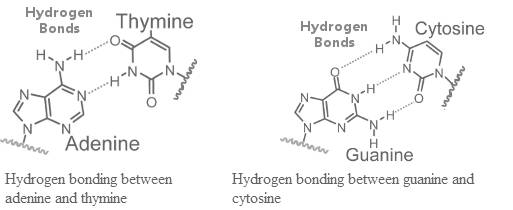
Concept explainers
Interpretation: The hydrogen bond donors and acceptors are to be determined in each of the four bases present in DNA.
Concept Introduction:
Answer to Problem 1P
The donors in the hydrogen bond are NH and NH2 groups, while the acceptors are the oxygen atom of the carbonyl group, and nitrogen atom that is not bonded to a hydrogen atom.
Explanation of Solution
The hydrogen bonding between guanine (G) - cytosine (C), and adenine (A) − thymine (T) is shown below:

From the hydrogen bonding in the above figure, it can be seen that −NH2 group of adenine forms bond with -CO group of thymine, and -NH group of thymine forms bond with the nitrogen atom of the adenine. Further, -NH and −NH2 groups of guanine forms bond with cytosine, and −NH2 forms bond with -CO group of guanines.
Hence, the donors in hydrogen bonding are -NH and −NH2groups, while the acceptors are the oxygen atom of -CO groups, and nitrogen atom involved in the ring.
NH and NH2 groups are the donors in the hydrogen bond, and oxygen atom of the carbonyl group, and nitrogen atom that is not bonded to a hydrogen atom are the acceptors.
Want to see more full solutions like this?
Chapter 1 Solutions
Biochemistry
- Upload a drawing of Gly-Met-Asn-Glu-His Label the alpha carbons Label the R groups as hydrophobic or hydrophilic Label the acidic and basic R-groups Label the peptide bonds Label the N terminus and the C terminusarrow_forwardWhy is the reaction rate low at pH7? Be specific and say something about the enzyme structure at the molecular level!arrow_forwardIn α-helices - what is the length of the hydrogen bonds between: TYR41H and GLU37O ALA39H and MET35O GLU38H and ILE34O THR36H and ARG32O. ARG32H and TYR28Oarrow_forward
- Serine protease enzyme mutation To show differences in the effect of the nucleophilic attack of the carbonyl group (C=O) of peptide bond between the catalytic triad of serine, histidine and aspartic acid, and another catalytic triad contains alanine, histidine and aspartic acid Provide/ draw an example of catalytic mechanism with catalytic triad contains alanine, histidine and aspartic Please answer completely will give rating surelyarrow_forwardModified TRUE or FALSE. Write the word TRUE if the statement is correct. If the statement is false, write the incorrect underlined word/s and indicate the correct word/s to make the statement true. Extreme temperatures and pH can cause permanent disruption of the protein primary structure(s) of enzymes that leads to loss of active site shape, loss of binding efficiency and activity.arrow_forwarddisadvantage of using protein blastarrow_forward
- Note:- Provide detailed explanation for the reaction that involves the removal of nitrogen from an alpha-amino acid, forming an alpha-keto acid. Please explain with the help of an example.arrow_forwardColor Reactions of Intact Protein: 1ml of water and 0.5 g of casein 1ml of water and 0.5 g of bean protein 1ml of water and 0.5 g of glutenarrow_forwardBeta ( ? ) sheets are a type of secondary structure in proteins. A segment of a single chain in an antiparallel ? sheet has a length of 80.5 Å . How many residues are in this segment?arrow_forward
 BiochemistryBiochemistryISBN:9781305577206Author:Reginald H. Garrett, Charles M. GrishamPublisher:Cengage Learning
BiochemistryBiochemistryISBN:9781305577206Author:Reginald H. Garrett, Charles M. GrishamPublisher:Cengage Learning
